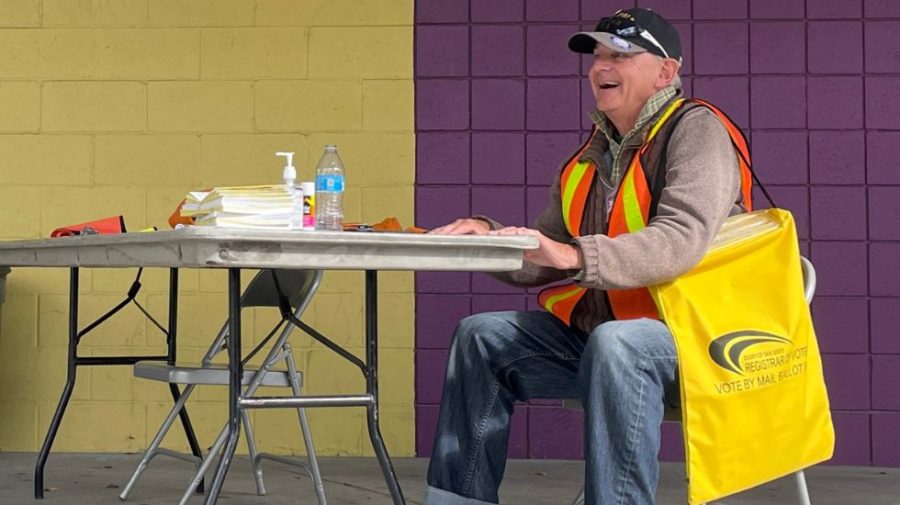Curiosity, code words and cute dogs: Essential poll workers share their motivations, fears
Three locals share their stories, proving poll workers are just regular folks
Joe Hlebica’s eyes light up when he sees an approaching voter ready to drop their ballot in the official yellow Registrar of Voters bag at Normal Heights Elementary on Nov. 7, 2022. Hlebica says the bag never leaves his side. Photo by Kathryn Gray/City Times Media
November 8, 2022
As a thin mist filled the air and dark clouds floated periodically overhead, poll worker Joe Hlebica met the cold without hesitation.
Wearing layers of clothing, a yellow ballot bag affixed to his shoulder and a continuous wide grin, he was ready to greet voters at the Normal Heights Elementary polling location.
Hlebica stood up from his metal folding chair to show the layers of clothing he was wearing, including a t-shirt, a flannel, a chunky collared sweater, heavy jeans and shiny brown leather work boots – a style, he said, some of his friends describe as akin to lumberjack chic or a city dweller who wants to give the impression they are rugged enough to cut down trees for a living.
Telling stories of his time volunteering at the San Diego Maritime Museum and living in Japan for 12 years, it’s as if he’s speaking to an old friend. Hlebica is both charming and social.
But Hlebica said his curiosity, not his love for conversation, attracted him to work the polls.
“I want to know, how does this thing work,” Hlebica said. “It has been a real lesson in civics. I can say to my doubting friends, associates and family with all confidence, (the voting process) is 99.9% foolproof.”
Hlebica is one of the thousands of diverse poll workers who dedicate their time to making the voting process possible in San Diego.
The San Diego Registrar of Voters starts weeks before Election Day recruiting poll workers, especially those with language or translation skills.
To qualify as a poll worker, according to the San Diego Registrar of Voters, you must be a U.S. citizen, registered to vote in California or be lawfully admitted for permanent residence, be at least 18 years old, and speak, read and write English.
In addition, workers are required to complete a two-day in-person training, be available up to 11 days during the two weeks leading up to Election Day, and have reliable transportation to and from their assigned polling center each day.
The motivation to step into the role was slightly different for poll workers and retirees Norma Stafford and Kelly, who requested her last name not be used for security purposes.
Kelly, who has worked the last four elections, said she keeps coming back for the human interaction and the pay, which is $15 per hour for a technical inspector and $17.61 for a precinct inspector, according to the San Diego Registrar of Voters.
During a phone interview with City Times, Kelly socialized and enjoyed fish tacos from a nearby food truck with co-workers she described as “just wonderful.”
Kelly says most voters are “extremely nice” and considers meeting them and their dogs a nice perk of the job.
There was only one incident where Kelly felt unsafe enough to alert law enforcement and recalled police arriving minutes after she called them.
“There was a guy running up the hill and yelling and running back down the hill and running back up,” Kelly said. “Then he started harassing the people in the park.”
This year, Kelly said, there is an extra level of protection for poll workers at her location, a code word to be used if there is a security concern and a pre-determined meeting location if there is an incident.
Hlebica’s location did not have a safe word, but a nearby police precinct was on alert and ready to respond in case of an incident.
Stafford, who was unable to participate this year due to a COVID-19 infection, said the only security situation she has encountered in over 40 years of working the polls was when she asked two voters to leave.
“I’ve had a couple of times when a couple of voters that were obviously on opposite sides would kind of start talking and you could tell that the heat was rising,” Stafford said in a phone interview with City Times.
Stafford, upset not to be working the polls this year, can’t think of many threats that would keep her from participating in the voting process.
From hosting a polling location in her house during the 1970s to working the polls in 2022, 80-year-old Stafford has no plans for sitting the next election out.
“I feel like I’m contributing,” Stafford said. “I’ve never missed voting in an election. It’s just one of those rights we have, and if we want to keep those rights, we must keep doing it.”
Hlebica, a retired science writer at Scripps Institute of Oceanography, isn’t so sure he’ll return to work the polls in 2024. Safety is his top concern, just as it was in 2021.
Signed up and ready to work the polls for the California gubernatorial recall election in September 2021, Hlebica said he ultimately got cold feet because he was “afraid of trouble.”
When attending his poll worker training at the San Diego Registrar of Voters in 2022, security remained Hlebica’s priority.
Concerned about the lack of scanners or metal detectors when he arrived at the San Diego Registrar of Voters building, Hlebica questioned his safety as a poll worker, pausing briefly to reconsider.
But ultimately, after being reassured the police would be on alert and a precinct was blocks away from his polling location, he decided to take the job.
By the end of Election Day, Hlebica will have spent almost two weeks between training and working the polls. But he describes himself as a “mail guy” who doesn’t wait long to vote.
“I get the ballot,” Hlebica said, “and within the first 24-48 hours I fill it out and drop it in the mail.”











